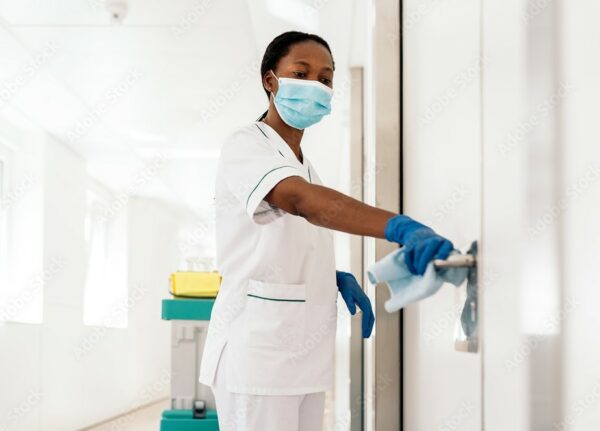Today, more than ever, we need to continue to focus on reducing and eliminating the risk of hospital-acquired infections. Our focus needs to be multi-faceted. We hear from many organizations that they have focused performance improvement activities happening within their Sterile Processing Departments. One area that often is overlooked is the general healthcare environment. Focusing your team members on these 5 areas can have a substantial impact on the overall cleanliness of your organization:
#1 Breaking the Chain of Infection
The most important actions we can take to break the chain or spread of infections is proper hand hygiene and simple covering of our coughs. Hand hygiene, when performed properly removes the germs from our hands so they are no longer available to be passed on to other surfaces including other people and even yourself. Covering our coughs, prevents the aerosolization of germs into the environment, again reducing the risk of those germs landing on surfaces and people. Additionally, ensuring that staff understand that cleaning products used within an isolation room could potentially spread germs if used to clean other areas is a key component of staff training.
#2 – Chemical/Cleaning Product Dwell times
Choosing the correct cleaning product is not an easy task. Cleaning products must be aligned with the instructions for use for each piece of equipment. This could easily translate into multiple types of cleaning products needing to be available and used in each department. Coaching staff to refer to the product label for instructions on how to properly use the selected cleaning product is essential as a product that is not left in contact with the surface being cleaned for the proper length of time is essentially useless. Making certain that staff understand the concept of dwell time or contact time is essential to the cleaning process. The instructions for use will also advise the user of the type of personal protective equipment that should be used to safeguard themselves from the cleaning product.
#3 – The process of cleaning
If there is not a systematic approach to cleaning a surface, the result could be the spread of germs as opposed to the elimination of germs. Infection Preventionists describe the process as cleaning from clean or cleaner areas to dirty or dirtier areas, then following a top to bottom, left to right approach. The order of clean to dirty and top to bottom reduces the risk of cross-contamination of surfaces while the process of left to right helps us assure we are not missing surfaces.
#4- High Touch Surfaces
Oftentimes, the smallest surfaces are the surfaces that are touched most frequently. Consider doorknobs, faucet handles, remote controls, and call bell devices. Some of these may easily be missed, especially that call bell device. Creating a cleaning checklist of everything in a room that needs to be cleaned as a reminder for staff is an easy way to get staff to focus on cleaning all the surfaces that need to be cleaned.
#5- Standardization of cleaning tools
The migration to the use of disposable tools has impacted the overall cleanliness within our organizations. But use caution, surfaces may appear to be clean, but be riddled with germs as a result of staff reusing or overusing disposable wipes and disposable mop heads. Understanding the instructions for use is essential for these products. Keep in mind that if the instructions for use do not provide you with sufficient guidance, reaching out to the manufacturer for further guidance should occur.
To learn more about Infection Prevention and Control contact the C&A team at 704-573-4535 or email us at info@courtemanche-assocs.com.


